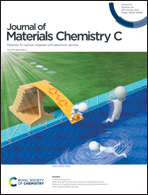Highly efficient solution-processed thermally activated delayed fluorescence emitter based on a fused difluoroboron ketoiminate acceptor: C/N switch to realize the effective modulation of luminescence behavior†
Abstract
Thermally activated delayed fluorescent (TADF) materials based tetracoordinate boron acceptors hold great potential for organic light emitting diode (OLED) applications; however, these emitters suffer from a low luminescent efficiency (ΦPL) and a large device efficiency roll-off. Herein, we design and synthesize two D–A-type emitters based on two fused boron ketoiminate (FBKI and aza-FBKI) acceptors and a 9,9-dimethylacridine (DMAC) donor. Through changing the carbon atom to a nitrogen atom in the fused boron ketoiminate units, a conventional fluorescent molecule (DMAC-FBKI) can be transformed into a highly efficient TADF molecule (DMAC-aza-FBKI) due to the dramatically reduced ΔEST (0.46–0.04 eV). DMAC-aza-FBKI exhibits a short delay lifetime of 2.2 μs and a large reverse intersystem crossing rate constant (kRISC ≈ 1.5 × 106 s−1), which is attributed to the rather close energy levels of its 3LE, 3CT and 1CT states based on theoretical calculations. Furthermore, compared with DMAC-FBKI (ΦPL ≈ 44%), DMAC-aza-FBKI has a higher ΦPL of 82% due to the existence of intramolecular hydrogen bonding. Consequently, the corresponding electroluminescent device achieves the highest external quantum efficiency (EQE) of 16.2% and an efficiency roll-off of only 9.3% at 1000 cd m−2, which are much better than those of the device based on the TADF-inactive DMAC-FBKI.



 Please wait while we load your content...
Please wait while we load your content...